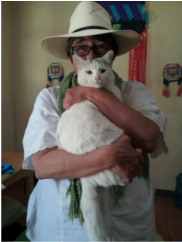|
I promised to post some photos of Antigua's Semana Santa, Holy Week celebration. I have already written a blog about this celebration, but it is nearly impossible to imagine without photos. Thousands of Antiguenens participate in this celebration, both walking with the processions and creating alfombras, carpets in the street. Some of the alfombras are shown in the slideshow below. They are made of pine needles and flowers, fruits and vegetables or colored sand applied to stencils. The designs are watered to keep them in place and fresh. The processions carrying Jesus and Mary walk through these beautiful carpets which are then destroyed by their passage. During the first days of the holy week, children are major participants, with the boys and men wearing purple robes and the girls wearing white. The women mostly wear black. A part of being in the procession involves carrying the elaborate statutes which tell the story of Jesus's last week. The men carry Jesus and the women carry Mary. The heaviest of these floats weighs 2 tons. Moving these enormous scenes, especially around corners, involves tremendous care and coordination of effort. All processions are accompanied by more incense (copal) than I have ever inhaled in my life, partly due to the enthusiastic boys swinging the incense censors. I promised in the last blog to post my pictures of the spring equinox at Uxactun, a Maya site associated with the completion of the Maya long count calendar. The night before the equinox featured a reenactment of the ancient Maya celebration of the equinox at the observatory of Uaxactun. Note the elaborate feathered headdresses on the actors. For anyone who has ever studied the Maya stelae and wondered what on earth that stuff on top of the leaders' heads was, these wild feather headdresses explain much. The next day many Maya shamen from around Guatemala participated in a traditional Maya shamanic ceremony, chanting and casting seeds, candles and other unknown things into the fire. I was happy to note that there were at least as many Maya women shamen present as there were men. As I alluded to in the last blog, the problem with going to an ancient site to see the alignment of light on these days is the fact that the sun must be shining first thing in the morning. As these sites are located in the jungles of Peten, areas which were deforested when the Mayas actually lived there, the sunlightwhich they tracked is not always available due to the mist rising from the jungle. The sense of being in a sacred and timeless dimension however, is present.
SO MANY REASONS TO LOVE GUATEMALA
I'm writing from Antigua, Guatemala, where I am continuing to make my way in Central America. I was fortunate to be in Uaxactun, the oldest and reputedly most acurate astronomy site in the Maya world, for the spring equinox. It was very magical to be in the ruins at night for the shamanic rituals and also the reenactment of a Maya procession. The headdresses were very elaborate with gorgeous feathers from the jungle birds, the stars beautiful and clear and the candles on the steps of the observatory made the ancient stones glow. Also there were about a hundred school kids to carry the Guatemalan flag. It was quite a crowd for this northernmost town in Guatemala, home to chicle gatherers a subsistence community living without electricity, and beautiful free horses who graze in the ruins and the field which run through the middle of town. It is usually one of the most peaceful places in Guatemala. The openess of the children there is in incredible contrast to meeting kids who have grown up with tv and computers. Not surprisingly, the children play together almost all the time. Unfortunately, on the morn of the equinox the sky was overcast, so it was not possible to see the path of the sun over the monument to the equinox. There were however a group of shamans performing the rites of the equinox at the base of the observatory, so there was plenty of celebration. Food, Beauty, Color, Craft and Etiquette 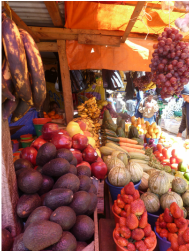 Visiting the local markets is one of the best parts of travel for me. I love to immerse myself in local markets following their narrow aisles through always a treat in Latin America, like stepping into a kaleidoscope of color, the smell of cooking food, the people wearing traditional and local clothing, the invitations calling me to draw closer to the vendor's avacados, blouses, jewelry. weaving, ice cream. The local market is a place of bustling self-employment and lively exchange. I don't think I'll ever understand why the modern world prefers megastores where the food is all in packages and the salespeople don't know nada about what they're selling. In the local market the experience of exchange is personal, knowledgeable and often negotiable. Like the city of San Cristóbal itself, the local markets in San Cristóbal are stunning, not only because of the vast diversity of the available items but also because of the artistic arranging of The Jade Museum, San Cristóbal de las Casas 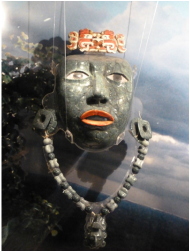 Among the many museums in San Cristóbal, the museum of jade was my favorite. It features fine reproductions of the Jade figures, masks and jewelry as well as ceramic statues found in ancient Maya, Olmec & Mokaya sites as well as a few pieces from the ancient Zapotecs and Mixtecs. The work is exquisite and the power and beauty of the jade as well as the red cinnabar accents makes each piece quite powerful. For the ancient peoples of mesoamerica jade was indeed the most precious of all materials. Jade was believed to facilitate the transition through the underworld after death. Jade also symbolized immortality, eternity, power and love. This museum also provides a excellent opportunity to understand the chronology of these ancient peoples. work from peoples more ancient than the Mayas, the Olmecs and the Mokaya. It was fascinating to observe the different ways that human figures were portrayed over 3000 years and among different groups. 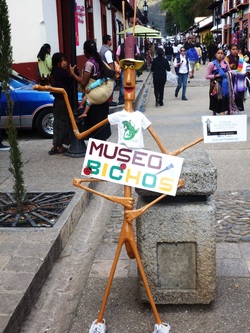 Museo de los Bichos, The Museum of Insects I was on my way to the museum of amber when I encountered a comic figure of a preying mantis on the walking street . Next to him a man held a live tarantula in his hand. I had held my first tarantula at Tikal and was eager to repeat the experience. For those of you who are afraid of insects and of enormous spiders in particular, holding a tarantula may seem like something you would never do. I understand this impulse. I met my first tarantula in Australia, in my bedroom, as a 17 year old exchange student. I was scared spitless. I screamed. Despite the reassurance of my hosts that tarantulas were not agressive unless provoked and that they were good at eating insects, the tarantula was killed. In fact I smuggled it home preserved in alcohol and showed all my friends this dead massive spider. Now that I know tarantulas I am sorry I behaved so aggressively towards this gentle creature. 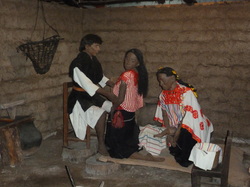 Scene of a Maya woman about to give birth The museum of traditional Maya healing is on the outskirts of San Cristóbal, past the sprawling local market. I was the only visitor and I was first led to a bench to watch an interview with a Maya midwife which included scenes from her helping a woman give birth. She was in charge of prenatal and postnatal care as well, performing protective spells and advising the new mother on nuturition and care of the baby. One of the very moving aspects of birthing in the Maya way is that the woman's husband sits in front of her and embraces her during labor. 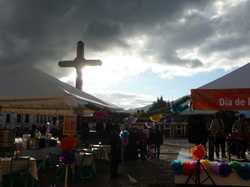 My love affair with San Cristóbal began almost immediately. Maybe it's because I always thought the perfect place for me as a writer would have been in Mexico City in the 30's or in ex patriot Paris. So San Cristóbal de las Casas immediately spoke to me, with it's walking streets, extensive markets, marimba bands, passionate latino singers and a vibrantly colored city more exhuberant than Flores and Antigua. Once the capital of Chiapas, San Cristóbal is considered the cultural center of Chiapas with a mix of indigenous Tlotzil Maya, ladinos and people from around the world. Set high in the mountains, San Cristóbal, named after Saint Christopher, is one of the coldest places in Mexico. 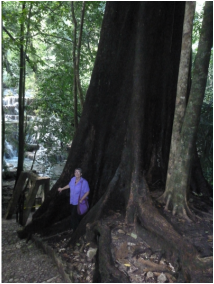 In the Maya World Tree, the Ceiba, Palenque I spent two months living in Flores, Guatemala, getting to know people in Uaxactún and San Jose and learning more about the ancient Maya sites. Three weeks ago, I left Flores in a minivan and then took a boat across the river that divindes Guatemala from Mexico. A taxi and another minivan later, I landed in Palenque, Mexico, home to another famous Maya site. I have been visiting the archeological sties of the pre-Christian people of Mexico for many years, from Chichen-Itza on the Yucatan Peninsula to Teotihucan near Mexico City. Until I came to Guatemala, Monte Alban, near the city of Oaxaca, was my favorite site. It's temples and pyramids mirror the rise and fall of the surrounding mountains, conveying such respect for the natural world and such harmony with it that I was moved anew every time I visited. I did not know that the ancient sites of the Maya in Guatemala would be equally powerful to me. In Petén and in Palenque, the spectacular jungle setting of the ruins emphasizes the mystic qualities of the Maya structures. |
Louise "Luisa" Wisechild, PhDI first visited Guatemala in 1995 as a member of the Vashon Island sister city delgation to Santiago de Atitlan, Guatemala. Archives
October 2023
Categories
All
|
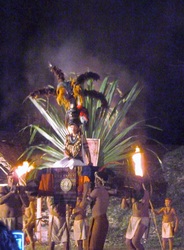
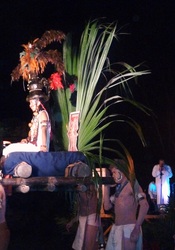
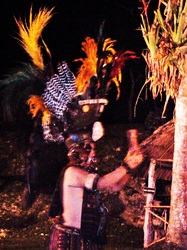
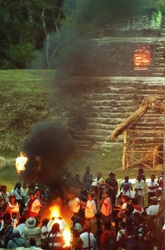
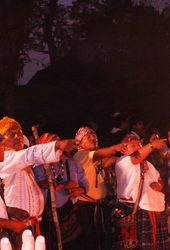
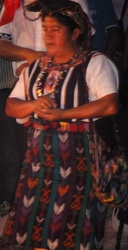
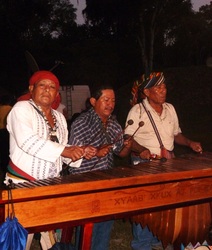
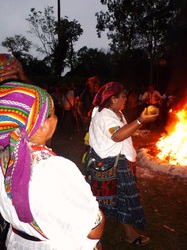
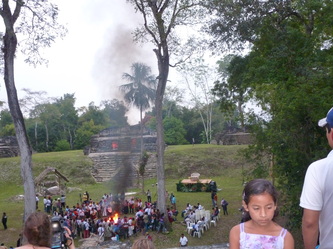
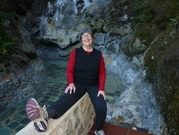
 RSS Feed
RSS Feed
